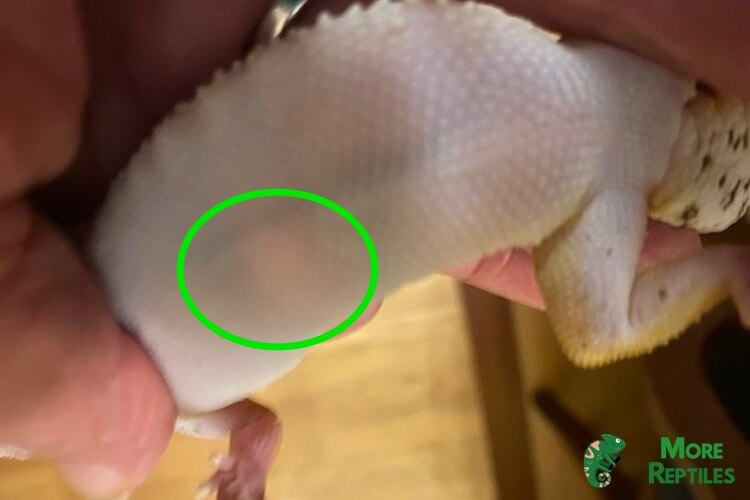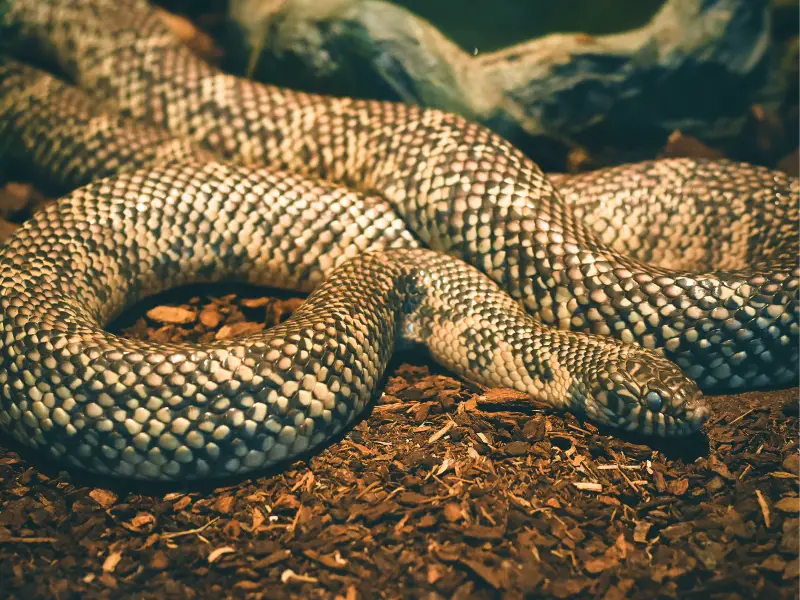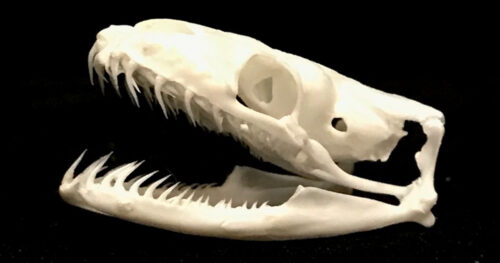Pregnancy in Leopard Geckos starts with ovulation.
Before she can have offspring, a female gecko has to ovulate to produce organic material that can turn into eggs. Ovulation bodies can be seen as small pinkish circles in the upper abdomen.
Having bred Leopard Geckos for 13 years, I never fail to get excited seeing these small pink circles! They are the first step in your leopard gecko’s reproductive cycle and can be the first signs of pregnancy.
In this guide I share everything you need to know about a pregnant Leopard Gecko. From signs and symptoms, to when to expect eggs and how to care for mom and her offspring, you will be well prepared…
Author Tip: Animals who lay eggs are called “gravid” before laying them. Animals who give birth to live offspring are called “pregnant”. For this reason, most experienced breeders use the term “gravid Leopard Geckos”.
What to Know
- Signs of a pregnant gecko include looking wide in the belly, restless wandering and trying to dig in the cage.
- Leopard geckos lay pairs of eggs every 2-6 weeks.
- The eggs can often be seen inside the belly and show up as small pinkish circles in the upper abdomen. Once the leopard gecko has well-formed eggs, these can be seen through the belly as white ovals in the mid to lower abdomen.
- It is important to make sure that gravid leopard geckos have the proper amount of calcium, vitamin D3 and minerals.
Leopard Gecko Pregnancy
Most female leopard geckos will show signs that they could produce eggs beginning as early as nine months old.
Leopard geckos lay pairs of eggs every 2-6 weeks during breeding season. In the northern hemisphere, breeding season begins in January or February and lasts until September or October.
Before she can lay eggs, she has to ovulate to produce organic material that could possibly turn into eggs.
Nearly all females will ovulate, whether they are going to become pregnant or not. After ovulation, if a gecko is not going to develop eggs, the material from the ovulation will be reabsorbed into her body.
If the female mates with a male (and sometimes even without mating) the ovulation material develops into a pair of eggs. The eggs spend 2-6 weeks growing and developing inside the abdomen. At six weeks, the eggs fill just about the whole of the abdomen. At that point, the Leopard Gecko digs a shallow hole and lays her eggs through her vent, which is between the hind legs.
Signs a Leopard Gecko is pregnant include:
- Looking wide in the belly
- Restless wandering
- Trying to dig in the cage
One of the best things is that the signs of ovulation and the eggs themselves can often be seen inside the belly! They show up as small pinkish circles in the upper abdomen, roughly between the front legs (as seen in the picture below).
The best way to look for this is to put the gecko in a clear plastic container and look at her belly from below. You can also gently hold her upside down in your hands and bend her back slightly so the contents of her belly are visible.
A first-time breeder may be worried about how to tell if the their female Leopard Gecko is pregnant.
Unfortunately, you may not always be able to tell just by looking at her.
Sometimes it can be difficult to tell whether or not there are eggs, even if you are an experienced breeder. Fat deposits, which are the same color and in the same part of the belly as the eggs, can be confused for eggs.
It is important to remember that, while there is a certain amount of preparation you can do, sometimes the only thing to do may be to wait!
Let the process happen and respond as it plays out.
The chart below shares the breeding cycle and what you can see during each phase:
Timeline
| Stage | What Is Happening | What To Look For |
|---|---|---|
| Dormant | It is not breeding season. | The whole belly is white with no structures visible. There may be small brighter white patches, but these are related to being ready to pee or poop. |
| Ovulating | The ovulation material begins to develop. This is when material that could develop into eggs appears, usually in pairs. | Small pinkish circles in the upper abdomen, close to where the front legs are. They look like a pencil eraser when seen from the top. |
| Formation of eggs | The eggs move toward the back of the gecko’s abdomen as they grow. | White ovals form and grow from the middle of the abdomen. They may be hard to see in the early stages of development, but as they mature they will become larger and more obvious. |
| Laying | The eggs will exit the gecko from the vent area between the hind legs. | A clutch of two eggs (in very rare instances it could be 1 or 3) will be laid, ideally in the lay box, but sometimes in other parts of the cage. |
Signs
Generally, the signs of a gravid Leopard Gecko include one or more of the following:
- Appetite changes
- Looking wide in the belly
- Restless wandering
- Trying to dig in the cage
During the 13 years I have spent breeding leopard geckos, I’ve learned there is more than just one way to tell if a Leopard Gecko is pregnant.
While she’s gravid, a Leopard Gecko may show changes in appetite (either eating more than usual or refusing to eat at all), or she may act “normal”. She may start to look very big and bulky around the belly. A female that is ready to lay may keep checking out the lay box, climbing in and out of it for days until she finally lays. Or she may ignore the lay box and lay her eggs in the water bowl!
Appetite Changes
Her appetite may decrease or disappear completely as she ovulates at the start of the breeding season. If an ovulating Leopard Gecko stops eating, the most important thing to do is to keep offering feeders on a regular schedule.
The next most important thing to do, and the most difficult, is to try not to worry.
She isn’t sick, she’s ovulating.
Reptiles can go longer without eating than mammals. They don’t need to burn calories heating their bodies like we do. Keep offering food and avoid force feeding, soaks or constant handling.
What Can You Do To Help?
Stop panicking! It is very hard for most reptile keepers to avoid panicking when their gecko stops eating, especially if it usually eats well.
Wide in the Belly
Some Leopard Geckos can look very big in the belly, just like a human woman does late in pregnancy. However, this doesn’t always happen. Although the Leopard Gecko below is big and chunky, she isn’t gravid; she isn’t even ovulating!

Some Leopard Geckos, especially the “chunkier” ones, have fat deposits in the abdomen which are in the same place as developing eggs. If you see white oval-shaped patches and they don’t get bigger, it is probably fat deposits.
Eggs will change in size over the period of a few weeks.
Pregnant Leopard Geckos who are ready to lay can look “pregnant” with a huge belly that drags on the ground. In my experience, most do not. The white eggs are visible, but the belly doesn’t protrude.
The eggs start to move downward to the mid-abdomen and start growing. They may be hard to recognize at first, but by the time they are nearly ready to be laid, they appear as large white ovals (as seen in the picture below).

At this point, you should provide her with a place to lay her eggs.
This usually involves setting up a “lay box”.
Grab a plastic container (such as a Tupperware) that is approximately 9”x7”x2” high. Cut a hole in the top, large enough that the gecko can easily get in and out. Finally, place a 1” substrate of moist coco fiber inside. Some breeders use sphagnum moss or vermiculite, but I have found that some geckos tend to eat these substrates! Coco fiber is the safest.
In my enclosures, the lay boxes doubled as humid hides.
It is also very important that your Leopard Gecko has the right supplements too; specifically calcium and vitamin D3.
She will be utilizing calcium to produce the eggshells. If she doesn’t have enough calcium in her body, the egg may not have a strong shell.
Dust all her feeder insects with calcium and vitamin D3 at every other feeding.
If she is not eating, dip your finger in water, and then dip the wet finger in the supplement. Spread some of the supplement paste on her mouth and let her lick it off. Since this provides more concentrated calcium, don’t do this more than once a week.
Some keepers keep a bowl of calcium in the enclosure.
For most of the years I have been breeding leopard geckos, I didn’t keep calcium in the cage.
I dusted the feeders with Repashy Calcium Plus and have never had a problem with poor egg formation.
Poor supplementation usually results in Metabolic Bone Disease where the gecko’s jaw and limbs become weak and rubbery due to calcium depletion. The gecko may become ill because her body is being rapidly depleted of calcium.
Restless Wandering
At six weeks, the eggs become large enough to fill the abdomen. She may become restless and walk around the cage more than usual. Occasionally, she may stay in one of her hides and be more lethargic than usual. It depends on the gecko.
What Can You Do To Help?
Provide a lay box. If you have been successfully supplementing and have provided a lay box, there is really nothing much more you can do to help.
There are two exceptions to this:
- Not using the lay box
- Egg bound
If your Leopard Gecko has already laid one or more clutches of eggs outside the lay box, you may need to give her the idea of where the eggs should go by putting her in the lay box several times a day. Don’t force her to stay there;, just put her in every now and then.
Most geckos who have laid in the “wrong place” (e.g. the water bowl or the poop area) eventually figure this out.
In rare cases, where she keeps laying outside the lay box, you may have to place her in a temporary enclosure where the entire floor is covered with coco fiber, kind of like a gigantic lay box.

A Leopard Gecko may not be able to successfully lay her eggs, which appear to be “stuck”. In 13 years of breeding a total of about 25 female Leopard Geckos, I only had one gecko become egg bound. It is often due to poor health or becoming gravid at too young an age.
Signs of an egg bound Leopard Gecko include:
- Straining in the lay box for days and days
- Extreme lethargy
- Passing watery yellow-ish material that looks like a burst egg
Eggs

Leopard geckos lay pairs of eggs every 2-6 weeks during the breeding season.
How frequently and how many times they lay depends on the individual and can’t be predicted.
Some females can become gravid and lay, even though they have never been with a male. These eggs aren’t fertile and won’t hatch, and this is not very common, as the following data will show.
Currently I have 19 female leopard geckos, ranging in age from 6-12 years. The six year olds have never been with a male and the older geckos haven’t been with a male in more than five years. Currently eight are ovulating, but only two are actually laying. These 2 lay 1-4 clutches of eggs every year!
Most leopard geckos who do not breed with a male may ovulate, but very few will actually lay.
For those who do, the process and care are the same as for pregnant Leopard Geckos.
Unfortunately, the keeper will not get to experience the joy of hatching.
Related: How to Breed Crested Geckos: 8 Steps (with Pictures)

Care
Breeding leopard geckos, which includes egg carrying, laying, incubating and hatching, is a wonderful and joyful experience. However, it can also result in some unfortunate outcomes. Egg laying takes a toll on the female’s body and may even shorten her lifespan.
When caring for a pregnant Leopard Gecko there are important steps to take.
Diet
Provide excellent nutrition and be prepared to provide a variety of nutritious feeder insects, including:
- Crickets
- Mealworms
- Superworms
- Hornworms
- Dubia roaches
- Silkworms
- Repashy Grub Pie
There is no need to provide every single type of feeder and cause obesity. Some ovulating and egg-carrying geckos won’t eat much, but it’s important to offer insects consistently.
Supplements
Breeding leopard geckos need plenty of calcium and vitamin D3 as well as other vitamins and minerals (including but not limited to magnesium, zinc, vitamin A, vitamin E). This helps them to produce healthy eggs and to remain in good health themselves.
Author Tip: For picky easters, supplements can also be made into a paste and spread on the gecko’s lips to encourage her to lick it off.
Environment
A stress free environment includes avoiding excessive handling, excessive “treatments” and keeping the tank in a quiet place.
Some keepers worry about small deviations in their geckos’ behaviors.
If the Leopard Gecko takes an extra day to poop, the keeper might soak it in warm water and give it mineral oil. If the gecko eats less than they’re expecting, they might decide to move it to different environments to see if it will eat better in a different location.
This is stressful.
Try to leave your lizards undisturbed. Read our guide on Leopard Gecko Habitat, Tank Setup & Ideas for setup ideas.
Record Keeping
Keep good records about your Leopard Geckos’ egg laying schedule and habits.
I recorded the date that each leopard gecko laid her eggs, kept track of how many clutches she laid, and listed the date that each gecko hatched and how many weeks it took from the time the egg was laid until the egg either hatched or turned out to be infertile.
Because of all this data, I had a good idea of what to expect from each female, based on what had happened so far during the season and what had happened in previous years.
This will help you sharpen your knowledge and understanding about when and how your geckos will lay.

Support
Asking for support from other breeders or friends and allowing yourself time to learn if things don’t go well are important steps.
In the case of egg development and laying unfortunate outcomes can include:
- Becoming egg bound
- Producing poorly calcified eggs
- Weight loss
- Dead gecko
It is always sad when things don’t go as well as anticipated, but this is part of the breeding process.



